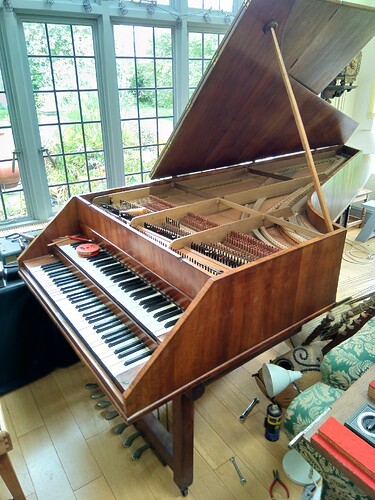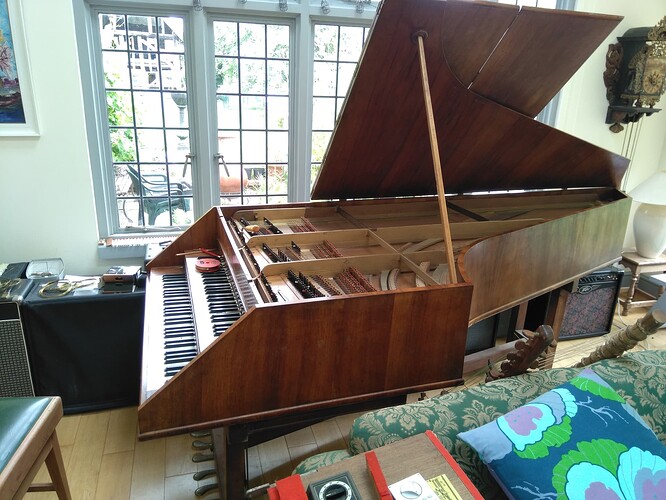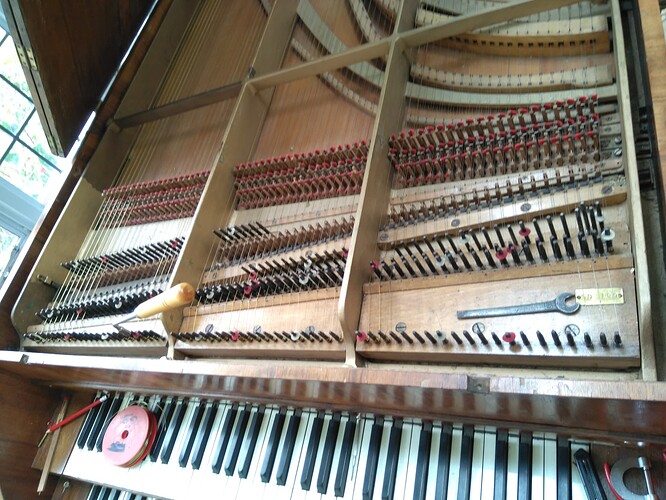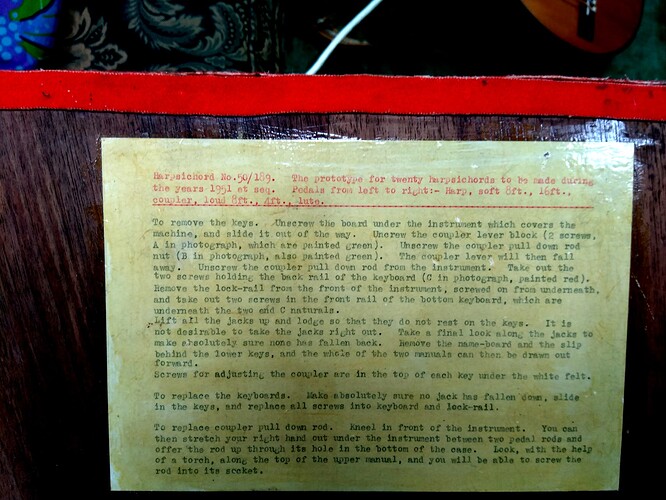I’m in the process of reviving an Alec Hodson harpsichord. It’s a big blighter on a cast iron frame, and features harp, soft 8’, 16’, loud 8’, 4’ and lute. I’ll post some pics if I can work out how…A previous owner made a stab at restringing the 16’ but has made a mess of it. Currently many of the strings are missing, and what are there are - probably - some original, and remainder recently added. The lower half of the jacks have leather plectra, the remainder Delrin. The scale length runs from 80" (f0) to 14" (g5). Is there some sort of formula for working out string gauges? Currently I can’t get anything like enough tension on the lower strings to make them pluck, rather than the plectrum just push the string upwards. Do I need wound strings perhaps?
You will need wound strings in the bass for sure. This is a problem, and an expensive one. I personally do not know who can make such, but I imagine other members may know. It is not easy to make your own.
You can search the forum using the search box for advice on how to determine a stringing list.
That will be A440 and modern steel for sure. I recommend Roslau piano wire, easily obtainable.
As to soft 8 foot and loud 8 foot, people do not refer to that. Because there are huge differences of opinion about relative strengths of the eight foots. Better to refer to upper and lower 8. After typing this I see the terms are used on the typed pasted note. Oh well.
An observation - personally I would not use a gooseneck hammer on a harpsichord. It’s far to easy to bend the pins. A traditional T hammer is better in my view, and easier to handle anyway. Also available easily.
It may help to contact a square piano specialist about wound strings, and they might be able to help with string calculations too: in the UK, I believe Lucy Coad is the main supplier of such, see https://www.squarepiano.co.uk/ and can probably also post abroad.
Possibly better than Röslau wire.
For normal harpsichords I agree with Andrew that T-shaped tuning hammers are better, but for a heavy Hodson “iron-framed blighter” a goose-neck might be more comfortable for tuning the bass strings. The tuning pins are likely heavy enough.
| mshields
July 6 |
- | - |
It may help to contact a square piano specialist about wound strings, and they might be able to help with string calculations too: in the UK, I believe Lucy Coad is the main supplier of such, see https://www.squarepiano.co.uk/ and can probably also post abroad.
Peter Barnes and Cesar Hernandez are other dependable winders of bass strings in the UK.
What is better? You don’t say, as far as I can see. It’s going to need steel.
I see online that Lucy Coad’s strings are made by Cesar Hernandez anyway, so best go straight to him or to Peter Barnes for advice. Andrew, you may be right that Röslau is fine, other people on the list are far better qualified than me to say.
Michael
Hi! By PM I can send you an excel tension table. It just gives a tension result ( kg / m2 ) based on length and diametre. You need to know independently the breaking point or ‘optimum’ tension for any given diametre. The one-tone below breaking point, as given by the manufacturer, as a rule of thumb for brass won’t work here with röslau steel, and doesn’t work for overwound neither. Gee, I wonder if this is helpful?
According to Hodson’s note pasted onto the harpsichord, he was intending to make 20 of these models. A long shot, but I wonder if that happened, and if so whether any others are still in existence.
How might one find out, I wonder.
Having once restored into playing order a 1929 Landowska Pleyel (which however had jacks and strings intact and was needed at the time also for modern music and historical museum reasons in Montevideo, Uruguay), I fail to understand the rationale behind spending lots of effort and money to restore this derelict instrument, a revival one that, once properly restored, will anyway sound badly.
@bobcube yes, it’s a good project, but given the expense of individual overwound strings and that you don’t have the originals to determine the gauges and overwinding specifications from, and that there is no excel spreadsheet or formula for calculating overwound tensions and properties that I know of, you are in a very dark and gloomy wood in this area. It’s problematic - experimenting and busting overwound strings is expensive.
I was brought one of these big beast years ago but another antique restoration shop had taken it apart and not kept any records of stringing and it was a disastrous mess. The owner blanched at the restoration cost. I quoted 15 years ago, so it has been sitting unclaimed. the antique shop, which otherwise has a very high-end reputation, had stripped the finish and gone right through the veneer. Many parts are missing. I made a list for the previous shop and while they promised the parts they never arrived so if anybody wants a Hodson carcass with metal frame come and get it! I do have the jacks I think I have the keyboards on a rack.



